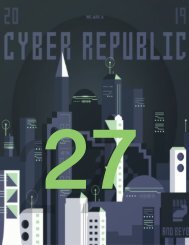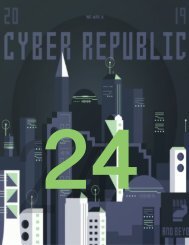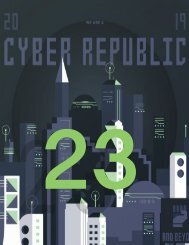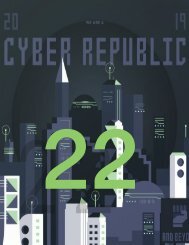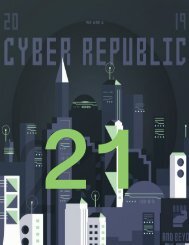Cyber Republic Weekly Update 15
Hello, fellow Cyber Republicans. On the last day of February, the Elastos Foundation published the 2018 Financial Report covering July 2018 to December 2018. https://news.elastos.org/wp-content/uploads/2019/02/Elastos-Financial-Report-English.pdf We will be delving into some details from the report and we’ll share some clarifications Elastos’ leader, Rong Chen, answered for the community. There's also some hot discourse in the community regarding Supernode pools along with a deep dive into DPoS written by yours truly. There is a stunningly active community in the Philippines that, through the voice of Krisha, we’ll be showing their significant activities. And lastly, the Cyber Republic is piling up suggestions on the Cyber Republic website. Vote for the projects you feel are most important. This is our ecosystem and we control our own destiny.
Hello, fellow Cyber Republicans. On the last day of February, the Elastos Foundation published the 2018 Financial Report covering July 2018 to December 2018.
https://news.elastos.org/wp-content/uploads/2019/02/Elastos-Financial-Report-English.pdf
We will be delving into some details from the report and we’ll share some clarifications Elastos’ leader, Rong Chen, answered for the community. There's also some hot discourse in the community regarding Supernode pools along with a deep dive into DPoS written by yours truly. There is a stunningly active community in the Philippines that, through the voice of Krisha, we’ll be showing their significant activities. And lastly, the Cyber Republic is piling up suggestions on the Cyber Republic website. Vote for the projects you feel are most important. This is our ecosystem and we control our own destiny.
You also want an ePaper? Increase the reach of your titles
YUMPU automatically turns print PDFs into web optimized ePapers that Google loves.
Supernodes, so it is important to vote<br />
accordingly.<br />
To understand what these nodes do, it's<br />
important to know what happens before<br />
the DPoS process. Elastos uses a dual<br />
consensus mechanism: Proof of Work (PoW)<br />
and DPoS. Elastos uses Merge Mining on the<br />
Bitcoin blockchain.The PoW miners<br />
produce the blocks and as stated in the<br />
Elastos DPoS Supernode Election article:<br />
https://news.elastos.org/elastos-dpossupernode-election-process/<br />
“The 36 active nodes will confirm the<br />
blocks previously produced by PoW<br />
miners.”<br />
Between the miners using PoW and the<br />
Supernodes using DPoS, this is how Elastos<br />
reaches full consensus for all transactions<br />
made in the ecosystem.<br />
For those interested in running your own<br />
node on the Elastos network, you’re in for a<br />
treat.There are several different avenues<br />
available. Many in the community are<br />
congregating together to build teams that<br />
will run Supernodes.There have been a<br />
number of proposals on how the payouts<br />
will be properly structured and also ensure<br />
there isn't any illicit activity between team<br />
members and voters.<br />
The first method is the use of the multisignature<br />
function in the Elastos wallet.<br />
Teams can set up a multisig wallet which<br />
requires a certain number of pool<br />
participants to sign the transaction.There’s<br />
a maximum of six and minimum of two<br />
owners to each wallet, and up to four<br />
required signatures to sign off on<br />
transactions.This ensures that multiple bad<br />
actors would be needed to betray the trust<br />
of a supernode team.<br />
This may be the easiest method, but it may<br />
not be the most ideal. Gandhi explains a bit<br />
more why a multi-sig option may not be the<br />
best course of action:“A multisig wallet is<br />
the easiest solution in my opinion but it<br />
has some deficiencies. For example, if one<br />
of the pool participants wants to leave the<br />
pool, you have to make a new multisig<br />
wallet, transfer the 5k ELA to a new wallet<br />
and register again for the election.” The<br />
constant flux of changing team members<br />
and creating new wallets may cause some<br />
headaches and become somewhat timeconsuming.<br />
Votes could be lost in the<br />
process.This brings us to a potential<br />
solution to this problem: creating smart<br />
contracts to streamline the process<br />
better.<br />
Smart contracts are the method in terms<br />
of divvying up ownership of a node and<br />
distributing rewards to its voters. Gandhi<br />
continues:“With a smart contract, one<br />
could find a solution to sell their stake of<br />
the node without the node having to go<br />
offline.The smart contract (or a second<br />
one) could also be used to share the block<br />
rewards with the voters. For example, you<br />
create a smart contract and deposit 5k ELA<br />
in it as a pool. The node owners set how<br />
much of their block rewards they want to<br />
share with their voters (ie. 80% for voters,<br />
<strong>15</strong>% for pool participants, 5% for running<br />
and maintaining the hardware).The smart<br />
contract detects automatically who is<br />
voting for your node and distributes the<br />
voting rewards. It doesn‘t make sense to do<br />
this in every block because this would be<br />
way too expensive, but let‘s say every 2<br />
weeks and as a voter you only get<br />
rewarded when you voted for the node for<br />
the whole 2 weeks period. The smart<br />
contract automatically distributes the<br />
rewards to the pool participants”.The<br />
Supernode pools can essentially automate<br />
the process in distributing rewards<br />
amongst themselves along with their<br />
community voters through smart<br />
contract.This would give many interested<br />
parties peace of mind that everything is<br />
being controlled by code.<br />
//9





